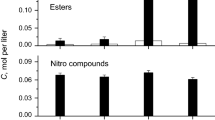Abstract
We investigated the effects of concentrations of NaI and methyl alkyl ketone on the formation of methyl iodide under gamma irradiation conditions. Without irradiation, the formation of methyl iodide does not occur. For the formation of methyl iodide, the solution pH should be brought to lower than 6 by radiolytic decomposition of ketones and air. At a pH below 6, the iodide was oxidized into iodine, allowing for the formation of CH3I from the reaction of iodine and the CH3 radical. When the concentrations of NaI and methyl alkyl ketone were similar, the concentration of methyl iodide was generally at its highest, and as the gamma dose increased, the concentration of methyl iodide increased.




Similar content being viewed by others
References
Lin CC (1980) Chemical effects of gamma radiation on iodine in aqueous solutions. J Inorg Nucl Chem 42:1101–1107
Paquette J, Torgerson DF, Wren JC, Wren DJ (1985) Volatility of fission products during reactor accidents. J Nucl Mater 130:129–138
Ishigure K, Shiraishi H, Okuda H, Fujita N (1986) Effect of radiation on chemical forms of iodine species in relation to nuclear reactor accidents. Radiat Phys Chem 28:601–610
Lucas M (1988) Radiolysis of cesium iodide solutions in conditions prevailing in a pressurized water reactor severe accident. Nucl Technol 82:157–161
Kupferschmidt WCH, Evans GJ, Jobe DJ, Melnyk AJ, Portman R, Palson A, Sanipelli GG (1992) The advanced containment experiments (ACE) radioiodine test facility experimental program. AECL Research, Chalk River
Evans GJ, Kupferschmidt WCH, Portman R, Palson A, Sanipelli GG (1994) Radiochemical analysis of iodine behaviour in the radioiodine test facility. J Radioanal Nucl Chem 180:225–235
Wren JC, Ball JM, Glowa GA (2000) The chemistry of iodine in containment. Nucl Technol 129:297–325
Taghipour F, Evans GJ (2002) Iodine behavior under conditions relating to nuclear reactor accidents. Nucl Technol 137:181–193
Jung SH, Yeon J-W, Hong SY, Kang Y, Song K (2015) The oxidation behavior of iodide ion under gamma irradiation conditions. Nucl Sci Eng 181:191–203
Keilholtz GW, Barton CJ (1965) Behavior of iodine in reactor containment systems. Oak Ridge National Laboratory, Oak Ridge
Nakhutin IE, Smirnova NM, Poluéktov PP, Tret’yak SA (1987) Problem of the sorption trapping of radioactive iodine in the form of methyl iodide. At Energ 62:445–449
Beahm EC, Lorenz RA, Weber CF (1992) Iodine evolution and pH control. Oak Ridge National Laboratory, Oak Ridge
Wren JC, Ball JM, Glowa GA (1999) Studies on the effects of organic-painted surfaces on pH and organic iodide formation. In: Iodine aspects of severe accident management workshop proceed, Vantaa
Taghipour F, Evans GJ (2000) Radiolytic organic iodide formation under nuclear reactor accident conditions. Environ Sci Technol 34:3012–3017
Bosland L, Funke F, Girault N, Langrock G (2008) Paris project: radiolytic oxidation of molecular iodine in containment during a nuclear reactor severe accident. Part 1. Formation and destruction of air radiolysis products. Experimental results and modeling. Nucl Eng Des 238(3542):3550
Moriyama K, Tashiro S, Chiba N, Hirayama F, Maruyama Y, Nakamura H, Watanabe A (2010) Experiments on the release of gaseous iodine from gamma-irradiated aqueous CsI solution and influence of oxygen and methyl isobutyl ketone (MIBK). J Nucl Sci Technol 47:229–237
Wren JC, Ball JM, Glowa GA (1999) The interaction of iodine with organic material in containment. Nucl Technol 125:337–362
Wren JC, Jobe DJ, Sanipelli GG, Ball JM (2000) Dissolution of organic solvents from painted surfaces into water. Can J Chem 78:464–473
Postma AK, Zavadoski RW (1972) Review of organic iodide formation under accident conditions in water-cooled reactors. Battelle Pacific Northwest Laboratory, Washington, DC
Beahm EC, Wang YM, Wisbey SJ, Shockley WE (1987) Organic iodide formation during severe accidents in light water nuclear reactors. Nucl Technol 78:34–42
Tietze S, Foreman MRS, Ekberg CH (2013) Formation of organic iodides from containment paint ingredients caused by gamma irradiation. J Nucl Sci Technol 50:689–694
Bosland L, Dickinson S, Glowa GA, Herranz LE, Kim HC, Powers DA, Salay M, Tietze S (2014) Iodine–paint interactions during nuclear reactor severe accidents. Ann Nucl Energ 74:184–199
Clément B, Cantrel L, Ducros G, Funke F, Herranz LE, Rydl A, Weber G, Wren JC (2007) State of the art report on iodine chemistry. Organization for Economic Co-Operation and Development, Paris
Ashmore CB, Gwyther JR, Sims HE (1996) Some effects of pH on inorganic iodine volatility in containment. Nucl Eng Des 166:347–355
Hong SY, Jung S-H, Yeon J-W (2016) Effect of aluminum metal surface on oxidation of iodide under gamma irradiation conditions. J Radioanal Nucl Chem 308:459–468
Driver P, Glowa G, Wren JC (2000) Steady-state γ-radiolysis of aqueous methyl ethyl ketone (2-butanone) under Postulated nuclear reactor accident conditions. Radiat Phys Chem 57:37–51
Glowa G, Driver P, Wren JC (2000) Irradiation of MEK-II: a detailed kinetic model for the degradation of 2-butanone in aerated aqueous solutions under steady-state γ-radiolysis conditions. Radiat Phys Chem 58:49–68
Guntay S (1996) Proceedings of the fourth CSNI workshop on the chemistry of iodine in reactor safety. PSI, Laboratory for Safety and Accident Research, Würenlingen, p 123
Sehgal BR (2011) Nuclear safety in light water reactors: severe accident phenomenology. Academic Press, Cambridge, p 505
Suppan P (2007) Chemistry and light. Royal Society of Chemistry, London, p 158
Hornback JM (2005) Organic chemistry. Cengage Learning, Boston, p 91
Gero A (1954) Studies on enol titration. II. Enol contents of some ketones and esters in the presence of methanol. J Org Chem 19:1960–1970
Acknowledgements
This work was supported by the Nuclear Research and Development Program through the National Research Foundation of Korea and funded by the Ministry of Science and ICT, Republic of Korea (No. 2017M2A8A4015281).
Author information
Authors and Affiliations
Corresponding author
Rights and permissions
About this article
Cite this article
Kim, M., Kim, T. & Yeon, JW. Formation of CH3I in a NaI and methyl alkyl ketone solution under gamma irradiation conditions. J Radioanal Nucl Chem 316, 1329–1335 (2018). https://doi.org/10.1007/s10967-018-5852-y
Received:
Published:
Issue Date:
DOI: https://doi.org/10.1007/s10967-018-5852-y




